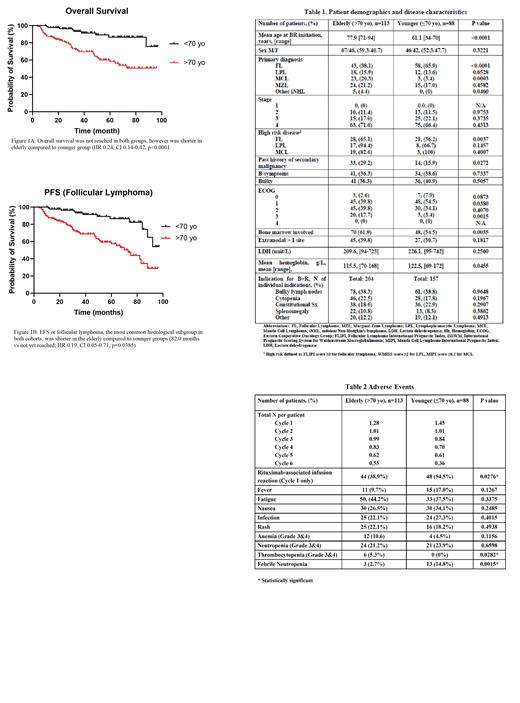Abstract
Background: Bendamustine plus rituximab (B+R) was established as a preferred first-line therapy for indolent non-Hodgkin's lymphoma (iNHL) and mantle cell lymphoma (MCL); however, few reports on the performance of this combination in the real-world setting in elderly patients are available to date.
Methods: A retrospective review of adult patients over 70 years (elderly) vs younger (<70 years) with iNHL and MCL who received first-line B+R at our institution from June 2013 to January 2021. We assessed safety, acute and late toxicity, and efficacy of B+R in elderly patients, compared to younger group.
Results: Among 201 assessed patients, 133 were elderly (mean age 77.9 years) and 88 younger (mean age 61.1 years) at time of B+R initiation. Baseline patient characteristics are presented in Table 1. There were more MCL in the elderly group: 20.3% vs 3.2% in the younger group. Significantly more patients in the elderly group had history of second malignancy. Prostate, breast, colon, and bladder cancer were more common in elderly, and lymphoid and thyroid in younger groups. Bulky lymphadenopathy, cytopenia, and constitutional symptoms were the most common indications for B+R initiation both in elderly (74.4%) and younger (79.26%) patients. Median number of B+R cycles was 6 for both groups. Mean dose of bendamustine received was 83.6 mg/m 2 in the elderly vs 88 mg/m 2 in the younger groups (p=0.0001). Full doses of bendamustine were given in 54% of elderly patients as compared to 79.5% younger patients. Treatment was delayed in 54% of the elderly and 43.2% of the younger patients. The mean delay time was similar in both groups: 20.1 [7-147] vs 17.1 [7-35 days].
The number of adverse events (AE) per patient was similar between the groups across each cycle (Table 2). Rituximab-associated infusion reactions were the most common adverse events in both groups. One patient in younger group developed prolonged neutropenia, lasting over 15 months. G-CSF support received 12.4% elderly and 22.7% younger patients. Nine patients (8%) in elderly and six patients (6.8%) in younger group (p=0.7604) developed transformed aggressive B-Cell lymphoma. Thirteen patients (11.5%) in elderly and five patients (5.7%) in younger group (p=0.1530) had secondary malignancies. Melanoma, metastatic squamous cell and renal carcinoma were more common in elderly group. Younger patients had metastatic squamous cell carcinoma and renal carcinoma, Kaposi sarcoma, MDS and thyroid cancer.
Overall response rate was 91.2% in elderly group vs 98.9% in younger group, including complete remission in 71.7% vs 84.1%. Median follow-up was 42 months [4.0-97.0]. Although median overall survival (OS) was not reached in both groups, it was shorter in elderly compared to younger group (HR 0.24, CI 0.14-0.42, p<0.0001) (Figure 1A). Relapse rate was 10.6% in elderly vs 4.5% in younger groups. Median event free survival (defined as time between the first treatment and one of the following events: progressive disease, relapse or death) for follicular lymphoma, the most common histological subgroup in both cohorts, was shorter in the elderly compared to younger groups (82.0 months vs not yet reached; HR 0.19, CI 0.05-0.71, p=0.0385) (Figure 1B)
Conclusion: In the real-world setting elderly patients had more advanced and high-risk disease, as well as higher ECOG status. B+R was associated with greater dose reduction and treatment delays. Adverse events profile and incidence did not differ significantly from the younger group. Response rates were lower, but relapse rate was higher in elderly patients. OS was inferior in elderly patients as compared to the younger group, due to higher rate of relapse and secondary malignancies.
Prica: Astra-Zeneca: Honoraria; Kite Gilead: Honoraria.


This feature is available to Subscribers Only
Sign In or Create an Account Close Modal